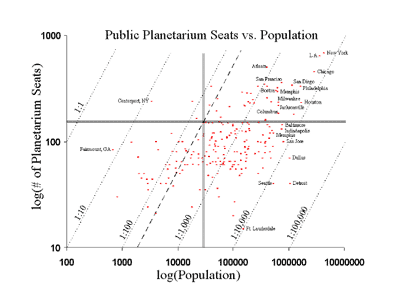Research Topics
Norman Herrett's Astronomy Legacy
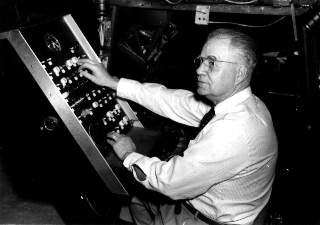 |
Norman Herrett was a teacher. His choice of vocation was all but guaranteed when, as a student, he was told by one of his professors that he'd never make a good teacher. Not only did he prove that prediction wrong, he went on to greatly exceed what most teachers might ever hope to achieve in a career. In talking to his students, the word that kept coming up was "genius," but perhaps not in way most people think of genius. Norman Herrett was not a man with a great deal of formal education. His scholarliness was a result of constant reading. What made him a great teacher was his unfailing passion, endless energy, and a philosophy that to have knowledge and not share it with others was perhaps the greatest crime a person could commit.
It was only natural then, that Norman Herrett's life would gravitate toward children. He had a keen ability to recognize talent and potential in them. And he appreciated their seeming endless ability to absorb the knowledge that he so gladly shared.
He came to Twin Falls in 1941, having taught public school in a number of states of the American West since 1926. This restlessness may reflect his dissatisfaction with the style of pedagogy that was prevalent in the public school systems of the time. So when he took a teaching position at Twin Falls High School upon arriving in the Magic Valley, it was just a matter of time before his creative drive found another outlet. While teaching in Montana, he and his wife Lillie had begun collecting and polishing agate. After a few years of refining their products, their sideline was occupying enough of their time to justify the inception of a small business selling the polished gems, and in 1946 Herrett’s Jewelry Store was born.
Earthly gems were not the only ones to catch his eye, however. For a mind with such limitless curiosity as Norm Herrett's, astronomy's infinite vistas attracted his attentions like a magnet. In 1955, after seeing an article in a popular science magazine describing how to grind and polish a telescope mirror, Herrett set about making his first telescope. In one of his characteristic bursts of creative energy, Norman began grinding his telescope's 6" mirror. Although he achieved satisfactory results, the experience convinced him that figuring mirrors was work best left for experts. This isn't surprising when you consider that once he decided to do something, he would often work unceasingly for twenty or thirty hours without rest until it was completed. Grinding and polishing a mirror typically takes much longer than this. Although he later built and sold many more telescopes, he never made another mirror. Instead he purchased optics, and used his mechanical ability to build unique instruments in which to install them. Some of his early telescopes' tubes were made from irrigation pipe, readily available in the agricultural Magic Valley.
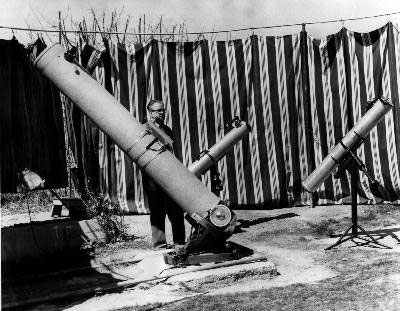 |
Herrett's first "observatory" consisted of a canvas curtain strung around the yard behind the jewelry store in the early 1950s. The curtains helped to block the lights from the growing town of Twin Falls that interfered with his celestial observations. Some of his neighbors didn't understand the curious curtain, which seemed to be designed to keep people from seeing what was going on behind the store. There were even rumors that Norman was starting a nudist colony right on Kimberly road! Family members recall waiting in line to use the bathroom behind visitors who were there to observe in the backyard.
Frustrated with the limitations that the curtains placed on his ability to see objects nearer the horizon, Herrett set about building an observatory. It would be placed one story above the ground, so that the nearby lights would be below the horizontal. It would also provide protection for his telescopes from the weather when not observing.
Prior to the observatory's construction in early 1955, his primary instrument, a 12½" Newtonian reflector, had resided in a low Quonset hut-like enclosure. Norman used to joke that it was the doghouse to which he was sent when he got in trouble with Lillie.
 |
The design of the 12½" telescope was indicative of Herrett's tendency to be ahead of his time. Although the optical arrangement was a standard configuration, it sat on a split-ring equatorial mount. At the time, just about the only telescopes in the world with such a mount were large research telescopes used by professional astronomers. Herrett appreciated the economy of this design. The telescope tube was less prone to flexure since its heaviest component, the mirror, was close to the pivot points. And moving the scope could be achieved with one hand, and didn't require a dangerously high ladder to reach the eyepiece.
Jim Woods, the Herrett Center's current Director and one of Herrett's protégés, remembers a particulary cold, clear night that impressed him with Herrett's passion for astronomy, and the sights afforded by the big telescope. Taking his turn after the young astronomers who had been observing before him, Norman climbed the ladder to the eyepiece. For a long time he said nothing, as the puzzled students looked at one another. Finally, his breath visible in the night air, Herrett simply uttered "This is magnificent!"
With a focal ratio of f/8, the tube of the 12½" telescope, now on display in the Herrett Center’s Keveren gallery, is over eight feet long. It did require a large weight to keep the telescope balanced about its rotational axes, and in typical Herrett style, he found an inexpensive solution from what others would have considered junk. Behind the primary mirror sits an automobile hubcap—filled with 200 pounds of lead. Only within the past few years have split-ring equatorial mounted telescopes become available to amateur astronomers, and fittingly the Herrett Center purchased one in the fall of 1996 for use in public observing sessions.
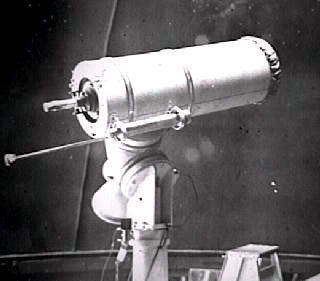 |
The second instrument in the observatory was also ahead of its time. The 10" Maksutov telescope was probably one of the largest such telescopes in amateur hands in the U.S. at the time. It was a new design created by a Russian, and its slow acceptance in this country might have had something to do with the Cold War sentiments of the day. No such impediments prevented Norman from appreciating the beauty of its design. It had the advantage of a long focal length, and therefore high magnification, in a relatively small package. It is currently in need of refurbishment—more about that later.
All in all, Norman Herrett constructed over 50 telescopes in his life—an impressive achievement. Most ended up in the hands of amateur astronomers in southern Idaho, who formed a group known as the Southern Idaho Amateur Astronomers. In addition to meeting at the observatory, they would also journey north of the canyon at night, where artificial lighting didn't hamper the views through the clear desert air. This group was the first formal amateur astronomical society in the Magic Valley, a tradition that continues to this day in the form of the Magic Valley Astronomical Society, an active group with a membership numbering over two dozen.
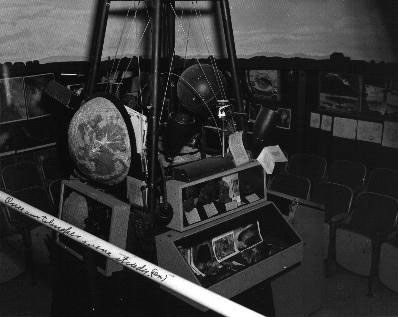 |
Norman Herrett was not a wasteful man, so the ground floor space below his observatory did not go unutilized. In it he constructed his planetarium, which for all its Rube Goldberg appearance was one of the most innovative of its time. Seating 45, it was comparable in capacity at the time to planetarium theaters in Denver, Portland, and Provo. The director of the Hansen Planetarium in Salt Lake City praised Norman on his innovations, including his northern lights projector, a highlight of a program that carried audiences to the latitudes above the Arctic Circle to see stars wheel about Polaris, directly above. Herrett was also an innovator in sound effects, utilizing old organ stops to simulate the plinking of meteoroids on the hull of a spaceship as the audience took simulated round-trip moon flights.
As the popularity of the observatory and planetarium grew, so did the workload. The excitement shown by young visitors inspired an idea that grew into what was possibly the greatest innovation of Herrett's life. Seeing how easily older students could relate scientific ideas to their younger peers, Herrett decided to train middle and high school students to present planetarium shows. It was 1955, and the "Kids Teaching Kids" program was born for which Norman Herrett would later receive much recognition, both local and national. Many of these students went on to careers in science and to become leaders in their communities.
 |
With the planetarium thriving under its student teachers, Herrett was freed up to pursue other interests. Since his youth in South Dakota, he had been fascinated with Native American culture and had collected artifacts from the Americas. What was once the Tower Café, adjoining the jewelry store, was annexed. With the additional space for the store to occupy, room was available for other of Herrett's interests, including tropical birds and fish. While recovering from a hospital stay, he began to think of other ways to use the space, and came upon the idea of allowing local artists to display their works. With so much to see inside, local schools, already on the premises to visit the planetarium or observatory, were offered tours. Herrett lined the walls with pottery and artifacts, many collected on his trips to Central and South America. Eventually the birds and fish departed, to be replaced by the beginnings of an anthropological and archaeological museum, the Herrett Arts and Science Center. Exhibits depicting space and astronomy themes were moved from the planetarium theater, where space was limited—display space that is—to the museum. Many of these displays represented Norman Herrett in his element: an artist in fiberglass.
Among the items of astronomical interest was his meteorite collection. These iron chunks of space debris had been collected from Canyon Diablo, now known as Meteor Crater, Arizona. Indicative of the importance Herrett placed on the museum as an active, rather than passive experience, one of the larger ones had a chain attached, so visitors could heft the irregular iron mass and easily imagine the sort of damage many tons of such stuff would do, arriving from space at 10,000 mph. Their presentation in the museum as astronomical artifacts as early as 1961 indicates that Herrett accepted what was considered a wild idea by most geologists of the time: the theory that the crater had formed by an impact from space, rather than volcanic processes. Again, Norman was ahead of his time: Meteor Crater’s celestial origins are now widely accepted.
By the end of the 1960s, Herrett's efforts had come to full fruition. Ten thousand school children per year were coming to visit the museum and planetarium. The Herrett Museum was now incorporated, and Norman began to consider its fate beyond his life span. In numerous meetings and letters with College of Southern Idaho President Dr. James Taylor, an agreement was forged in 1972 to donate his substantial collections to the College, in return for a promise to construct a building to house them. Herrett fully expected that a planetarium and observatory would be part of the building, once it was constructed.
It took six years of planning and fundraising to take the next step. In September of 1978, ground was broken for the new Herrett Museum, on a spot where local sportsmen had once hunted and fished in a swampy glen, about the time the Herretts moved to Twin Falls. The new building was dedicated on June 13th, 1980, but sadly Norman Herrett did not see that day. He had passed away on November 4th, 1979, secure in the knowledge that his great legacy would continue with the support of CSI, a generous community, and the dedication of a small group of his talented protégés. His energy still permeates the place.
 |
The story of Norman Herrett's legacy does not end there, however. In some ways it had just begun. Although the new facility had nearly ten times the square footage of the cramped Kimberly Road museum, it did not include a planetarium or observatory. This would change when the seed of astronomy interest that Norman Herrett had planted in the people of the Magic Valley, young and old, sprouted into action.
A little more than a decade after the new building opened, a ground swell began in the Magic Valley. Spearheaded by Dr. Al Frost, a plan to expand the museum was forming. Included in that expansion would be a world-class planetarium theater. The plan caught fire when local clothier Earl Faulkner threw his support into the project. With a ground-breaking ceremony in December, 1994 the bulldozers broke ground for the addition to the Herrett Center that would include the Faulkner Planetarium, which opened on November 19th, 1995. Four model rockets were launched, representing the new facility and its three specialities: art, anthropology, and astronomy.
Visitors from outside the Magic Valley sometimes express surprise that the town of Twin Falls, with a population of under 30,000, would be able to support a 151-seat multi-million dollar planetarium theater.
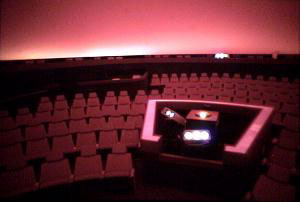 |
If Twin Falls were any other town, their skepticism might be well founded, but this, after all, is Norman Herrett's turf. One of his student lecturers, Chris Talkington, remembers Norman's boundless curiosity and energy. Without reservation Chris credits his own success to the guidance he received from Herrett, whom he considers one of the most religious men he has ever known. Not in the traditional sense to be sure, but in his tireless passion to understand man's place in what Herrett called the mysterious and exciting universe of which we are all a part. He would say that he was being led to do the things he did, but by what he didn't know. This passion was contagious enough to spread to an entire community, and become Norman Herrett's legacy.
How can we measure a legacy? As a scientist, I wanted to be able to do so in as concrete a way as possible. On the assumption that the success of the Faulkner Planetarium is one way, I compared its size to the size of other theaters around the country, and the populations of the cities that they serve, using data from the 1990 U.S. census and the International Planetarium Society's 1995 Directory of the World's Planetariums.
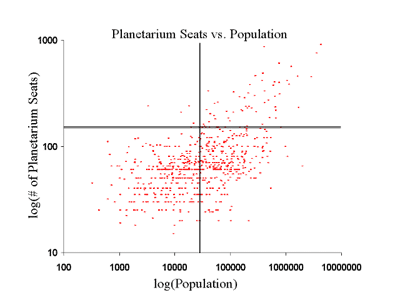 |
The plot above shows every city in the country containing one or more planetarium theaters for which data were available (about 700 cities). The axes are logarithmically scaled, with each tick mark representing a factor of ten larger number than the previous. The number of planetarium seats represent all theaters in each city combined. Large cities are located at the right of the graph, small on the left. The Faulkner Planetarium is indicated by the cross. Notice several things: First, we are about in the middle of the graph in terms of population. Since the data are plotted on a log scale, that indicates that most cities larger than Twin Falls with a planetarium have a significantly larger population. In fact the average population of all cities with one or more planetaria is 99,800. Next, look at the number of seats offered: The average number of planetarium seats per city is 86. The Faulkner Planetarium offers 151, the highest number of any city in our population strata. The next higher population city that has a comparable number of seats is Harrisonburg, Virginia (pop. 31,000) with 2 smaller theaters; the next lower is Richmond, Kentucky (pop. 528) which is the only theater in the vicinity of the much larger city of Lexington. Finally, we are in the 91st percentile of number of seats offered by all cities with a planetarium, above cities like Detroit (pop. 1,000,000), Baltimore (pop. 700,000), and Seattle (pop. 500,000).
These statistics become even more dramatic when you only consider public planetarium theaters. Many of the theaters in the first plot were school theaters, where some school districts built many small theaters, not open to the general public. The Faulkner Planetarium, of course, offers programs for both public and school groups, so perhaps a better comparison would be with like theaters.
The plot above shows those data. By population of cities with public planetarium theaters, we are now in the 25th percentile. But of the number of seats offered by those cities, we are in the 81st percentile. The number of seats offered is not necessarily the best indication of how well a theater serves its community, however: A large theater in New York City might not provide as much service as a medium-sized theater in a very small community. With this in mind, let's consider the ratio of number of seats available to the population of the city, in other words, how many persons per seat. On these plots, theaters with a given ratio fall along diagonal lines, running from lower left to upper right. By this ratio, we are in the 83rd percentile nationwide, with a ratio of about 128 persons/seat. And just so you don't think I'm too biased, consider the case of Fairmount, Georgia. This tiny hamlet of 657, located a half hour from Atlanta, Georgia, and Chattanooga, Tennessee (each of which, incidentally, have their own large planetarium theaters), boasts of an 83 seat theater, and thus a ratio of one seat for every seven citizens.
And lest there be any doubt that the theater is thriving, consider the following: When the theater opened in 1995, shows were sold out for weeks afterwards. From the time it debuted to mid-April, 1997, the show "Comet: From Ice to Fire" has sold out one out of every six shows, averaging nearly half capacity for all shows in that time. All told, over 23,000 students from southern Idaho and surrounding areas have visited the planetarium since opening. The people of the Magic Valley have a love and interest in astronomy that is well above average, as I think these numbers show.
Also indicative of the astronomical interest of the people of this region is the success of our star party program. Since its inception in the fall of 1996 with the first use of the JMI-18 telescope, monthly star parties have been well-attended on every clear night on which they have been held. Special event star parties, such as for the lunar eclipses of last fall and this spring, and Comet Hale-Bopp viewing, have attracted as many as 300 people. The members of the Magic Valley Astronomical Society, another tangible sign of Norman Herrett's influence, have lent a hand (and quite a few telescopes) to offer celestial views to star party attendees.
Two months before he died, Norman Herrett wrote a letter to CSI president Dr. James Taylor. In it, he spelled out his recommendations for what should be done with his telescopes, including a suggestion about where CSI might build an observatory to house them:
Herrett's recommendation for an observatory in Rock Creek Canyon was driven by two considerations. First, he thought that it needed to be in a location where light pollution interference would be minimized. Second, he surmised that most of the people using it would be interested amateurs. Since that time, however, some things have changed. Certainly, light pollution has increased. When Herrett came to Twin Falls in 1941, its population was only about 11,000. Currently, it is fast approaching three times that number. Also, a much greater percentage of the outdoor lighting fixtures now in use utilize gas vapor bulbs, not the incandescent variety. In recent years, filters have become available for telescopes which can selectively block out he much of the light emitted by mercury vapor and sodium lamps.
And as the popularity of our star parties demonstrates, more than a few people are anxious to get a view through the eyepiece of a telescope.
At the Herrett Center, we have begun to take the next step in realizing Herrett's dream of a new observatory. In doing so we have identified a number of considerations to be made.
- Location. Certainly better viewing could be achieved by getting away from city lights. But as Twin Falls grows, its light pollution will as well. Local amateurs report that they are now traveling twice as far away from Twin Falls as they were just a
few years ago, in order to find dark skies. Locating the observatory too far away would discourage visitors, whereas having one on site would greatly increase its accessibility. Just south of this building is a semicircular mound. Locating an observatory
on it would allow visitors to the museum to take a short stroll after an evening planetarium show to see the wonders of the sky first hand.
Nebular filters can help reduce the impact of light pollution, but more is needed.
A movement has begun in this country toward better designed lighting. Safety concerns dictate that simply eliminating poor lighting is not acceptable. However, lighting can be modified to serve the needs of both safety on campus, and enjoyment of the night
sky.
Comet Hale-Bopp amongst the stars of Perseus, as seen from 1 mile NW of the College of Southern Idaho campus. 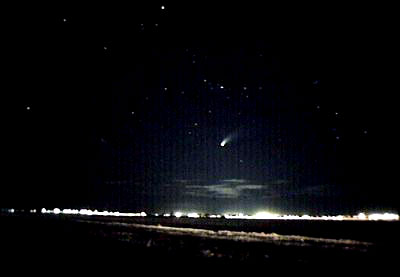
Both of these photos were taken about 10 PM on April 5, 1997. Nikon 24mm lens, 30 second unguided exposures on Ektachrome 400 ASA color slide film. The majority of the lights that we need to be concerned with are right here on campus. This can be seen in a pair of comparison shots taken on the same night, above. The image on the left was taken from ½ mile northwest of campus. The image on the right is on the same film, and the same length exposure, but from the proposed observatory site. The solution is simple. In order to keep lights on campus from hampering sky views, they will have to be modified. This can consist of a simple "hood" that allows light to shine only in the area immediately below the fixture. Such lights are known as full cutoff, because they cut off all stray light that would be wasted by shining up into the sky. These lights are preferable for security reasons as well—without the glare of an unshielded lamp, the pupil opens wider and it is easier to distinguish fine detail, like human facial features, that would be otherwise lost in the glare. Obviously, there is an initial investment required to realize a shift to better lighting. Since the observatory is still in the planning stages, I would propose that beginning the lighting plan now will make it economically feasible to phase in the modifications, so that real improvement will have begun by the time funds for the observatory itself have been raised and construction has commenced.Comet Hale-Bopp, as seen from the proposed site of a new observatory on the CSI campus. The Herrett Center for Arts and Science can be seen at lower right. 
- The instrument. One of Norman Herrett's concerns about a public observatory was the accessibility of the instruments that occupy it. He very much wanted telescopes that would be usable by all. We feel that the design that best meets this criterion is a
Springfield mount with a Coudé focus. This unique design features a series of folding mirrors and hollow rotational axes which allow the eyepiece to be placed in a permanent position, irrespective of where the telescope is pointing in the sky. Such
an instrument can be designed to be accessible to small children and persons in wheelchairs.
In discussions with Torus Precision Optics, a telescope manufacturer in Iowa City, Iowa, a tentative design has been proposed. The instrument is a 24" Classical Cassegrain. This is a large aperture, which typically would be reserved for a darker site, since
large aperture is needed for faint targets. Theoretically a 24" instrument would be capable of seeing objects as faint as magnitude 15.7. (That's almost 5000 times fainter than can be seen with the naked eye.) From preliminary tests performed on campus, I
estimate that the current limiting sky background is approximately magnitude 12 or 13. So why do we need such a large instrument?
24" classical Cassegrain telescope on a Springfield mount. Mirrors are shown in blue. 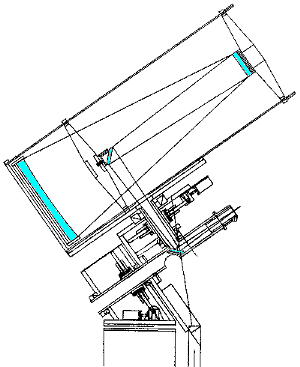
- Usage. In order to answer the question at the end of the preceding section, we should understand what the observatory will be used for. Of course it will be a public observatory, like Norman Herrett’s. Patrons to the museum and planetarium would be able to come out on public observing nights, and after a short stroll from the current building, be able to view the moon, planets, star clusters, galaxies, nebulae, and many other targets. In addition, the facility could be used as a teaching observatory for CSI astronomy classes. Toward this end, we would like to refurbish the 10" Maksutov, and install it on a mount that would make it safer and easier to use, to address Mr. Herrett's concerns. New mounts are now available, such as a guiding altitude-azimuth fork mount, that were not available in the late 1970s. Finally, we would like to be able to bring a live image from the telescope into the theater, for projection with the video systems. This is why large aperture is needed. Solid state camera technology is advancing at a rapid pace. Larger and larger imaging arrays are becoming available. As higher resolution camera arrays become available, this will be the least expensive item to upgrade in the data chain from telescope to camera to projector. The telescope must have large aperture so that any lack of sharpness in the projected image is not due to the telescope's lack of resolving power, or the ability to distinguish fine detail. Resolving power scales linearly with aperture; twice the aperture produces twice the detail. Also, the sensitivity of video cameras is still relatively low. In order to have an image that is bright enough to be discernible, especially of faint targets, a large aperture is needed. And as the lighting situation improves in the surrounding area, we can expect to image fainter and fainter targets. It should be a good measure of the success of our light pollution control efforts.
Norman Herrett's legacy was threefold. He left the community of Twin Falls an outstanding museum of the anthopology of American peoples and contemporary art. He also left an awareness of the value of a world-class planetarium, and an appreciation for experiencing firsthand the wonders of the night sky. All but the last of these legacies are now realized in the Herrett Center for Arts and Science. We are on our way, however. By the end of this year we hope to have a preliminary plan for the structure and major components of a new public observatory.
December 8th, 2004 will mark the 100th anniversary of Norman Herrett's birth. On that date, I can't imagine anything more appropriate than visitors to the new observatory on the CSI campus stepping up to the eyepiece to exclaim "This is magnificent!"
I would like to thank the following people for help in preparing this lecture and web page:
Mrs. Marion Kerr, Jim Woods, Nick Peterson, Rick Greenawald, Steve Clegg, Tyler Studebaker, Chris Talkington, Debbie Hartwell, Wilma Titmus, Steve Poppino, and Karen Hudson.
